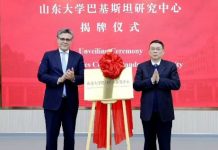By Ding Yiting, People’s Daily
A wind farm consisting of 125 smart wind turbines is currently under construction in the Kazak autonomous county of Mori, Changji Hui autonomous prefecture, northwest China’s Xinjiang Uygur autonomous region. Each of the wind turbines has a diameter of 186 meters and they are expected to generate 2.2 billion kWh of clean electricity on an annual basis.
According to Gao Xiang, vice general manager of the company that developed the wind farm, which is also a subsidiary of Huadian Xinjiang Power Co., Ltd., with sensors installed in the parts of the wind turbines and advanced control technology and algorithm, the wind turbines can detect potential variations of the wind to maximize their performance.
Besides, smart equipment in the wind turbines can also monitor the status of the towers and the vibration of the rotors, which helps reduce the loss of possible malfunctions and shutdowns, Gao noted, adding that the operation and maintenance cost of the smart wind turbines is 20 percent lower than that of traditional types.
The new energy sector, represented by wind power, is developing rapidly and gaining increasingly higher competitiveness in China.
As more and more new energy projects are built across the country, which fuels market competition, lowering costs and improving efficiency through digitalization and the application of intelligent technologies have become vital for many enterprises.
Qin Haiyan, head of the Chinese Wind Energy Association under the China Renewable Energy Society, told People’s Daily that the engineering quality and reliability of wind power equipment have been continuously improved over the years, and these pieces of equipment are becoming more digital, intelligent, and customized.
Today, the efficiency of China’s wind power generation is up 30 percent from a decade ago. According to statistics, the levelized costs of energy for wind and photovoltaic power generation in 2021 were down by 48 percent and 70 percent from 2012, respectively. This has laid a solid foundation for the large-scale and market-oriented development of the new energy sector.
In Jiaxing, east China’s Zhejiang province, “super roofs” that are able to generate electricity are employed by a building-integrated photovoltaics (BIPV) project launched by Beijing Energy International Holding Co., Ltd., a leading provider of global eco-development solutions.
Different from the traditional model under which PV panels are installed on mounting systems, the BIPV project adopts multi-layer roofs with built-in solar panels.
“BIPV makes photovoltaic power generation an integral part of buildings,” said Zhong Baoshen, chairman of LONGi, the world’s leading supplier of solar PV solutions based in Xi’an, northwest China’s Shaanxi province. No space for mounting systems is needed, so it is able to fit larger PV panels and thus increase generating capacity by about 15 percent, Zhong noted.
He told People’s Daily that the technology, apart from being promoted among new buildings, also enjoys large development potential in the market of roofing renovation.
Green electricity resources are being employed by a number of areas across China to build zero-carbon industrial parks. In an industrial park in Erdos, north China’s Inner Mongolia autonomous region, 80 percent of electricity consumed comes from local wind and PV power generation systems, while the remaining 20 percent is green electricity purchased from the National Grid.
Apart from the industrial and construction sectors, the vast countryside in China also provides a huge developmen spacet for new energy.
“I had to spend more than 300 yuan ($43.46) per month on the lighting of my cowshed. It is the PV panels on my roof that have reduced my electricity cost,” said Party head of Huatugula village, Tongliao, Inner Mongolia autonomous region, referring to a comprehensive intelligent new energy project in the village, one of the many PV and wind power projects built by the State Power Investment Corporation in the village last year.
Sun Wen from the corporation told People’s Daily that the company has rented local saline and alkaline land and managed to improve the soil quality of it. The land was later contracted to the villagers for free, and PV panels were installed on it.
“The village can also make 100,000 yuan per year from land lease,” Sun said.
Promoting rural wind power and PV development is an important approach to reaching the “dual carbon” goals as well as an effective measure to expand the collective economy of villages and increase farmers’ income.
A plan on renewable energy for the 14th Five-Year Plan period (2021-2025) proposed to vigorously build county-level wind power projects in rural areas, and encouraged the construction of distributed PV panels on the roofs of rural houses meeting the specific standards and designated sites in villages.
“According to estimation, a village can gain an extra 200,000 yuan each year if it spares 200 square meters of land and installs two to three wind turbines on it,” said Qin.
An official with the National Energy Administration told People’s Daily that China will focus on the diversified development of the energy sector during the 14th Five-Year Plan period, promote the integrated development of PV-assisted desert control, PV corridor, offshore wind power, and offshore oil and gas, launch demonstration projects such as massive hydrogen production through renewable energy, and explore new development models under which multiple energy sources complement each other and are comprehensively utilized in multiple scenarios.












